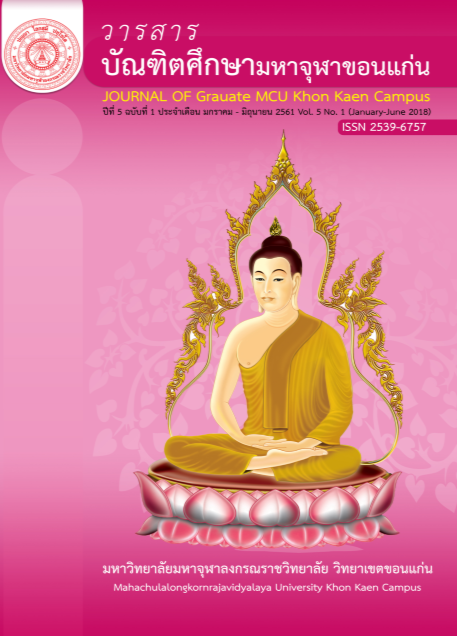การสื่อสารเชิงพุทธเพื่อสร้างความปรองดองในสังคม
Main Article Content
Abstract
การวิจัยครั้งนี้มีวัตถุประสงค์เพื่อ 1) ศึกษาแนวคิดและทฤษฎีการสื่อสารเชิงพุทธเพื่อสร้างความปรองดอง 2) ศึกษาสภาพปัญหาด้านการสื่อสารเพื่อสร้างความปรองดอง และ 3) เพื่อศึกษารูปแบบและกระบวนการการสื่อสารเชิงพุทธเพื่อสร้างความปรองดอง ใช้รูปแบบการวิจัยเชิงคุณภาพ ผสมผสานระหว่างการวิจัยเชิงเอกสารและการสัมภาษณ์เชิงลึก ผู้ให้ข้อมูลหลักได้มาโดยการเลือกแบบเจาะจง ได้แก่ 1) พระสงฆ์ จำนวน 8 รูป 2) นักวิชาการหรือผู้ทรงคุณวุฒิ จำนวน 10 รูป/คน 3) พนักงานองค์กรปกครองส่วนท้องถิ่น จำนวน 4 คน และ 4) ผู้นำชุมชนหรือปราชญ์ชาวบ้านจำนวน 10 คน รวมทั้งสิ้น จำนวน 32 รูป/คน เครื่องมือที่ใช้ในการวิจัยเป็นแบบสัมภาษณ์เชิงลึก วิเคราะห์ข้อมูลด้วยวิธีการพรรณนา (Descriptive analysis) ตามหลักอุปนัยวิธี (Inductive Method)
ผลการวิจัยพบว่า
1) แนวคิดและทฤษฎีการสื่อสารเชิงพุทธเพื่อสร้างความปรองดอง พบว่า เป็นการสื่อสารด้วยสติและปัญญา มีความรอบคอบในขณะทำการสื่อสารโดยมีเป้าหมายเพื่อให้ตนเองและผู้อื่นมีความสุข ยึดหลักกัลยาณมิตตธรรม หลักสัปปุริสธรรม เบญจศีลและเบญจธรรม หลักอริยสัจ หลักไตรลักษณ์ บนพื้นฐานของสัมมาทิฏฐิ คุณค่าแท้และประโยชน์ที่แท้จริง ส่วนปัญหาการสื่อสารเกิดจากอคติ และขาดการพิจารณาด้วยเหตุผลก่อนเชื่อข้อมูลข่าวสาร ควรยึดหลักหลักโยนิโสมนสิการ กาลามสูตร และปรโตโฆสะ การสื่อสื่อสารเพื่อสันติตามหลักไตรสิกขา และตัวชี้วัดการสื่อสารเชิงพุทธเพื่อสร้างความปรองดอง ประกอบด้วย สาราณียธรรม 6 สังคหวัตถุ 4 และ พรหมวิหาร 4
2) ศึกษาสภาพปัญหาด้านการสื่อสารเพื่อสร้างความปรองดอง พบว่า มีอยู่ 8 ประเด็น คือ (1)ความต้องการมีอิทธิพลต่อกัน (2)การมีทางเลือกที่หลากหลาย (3)ความต้องการเปลี่ยนแปลงความเชื่อ อารมณ์ และพฤติกรรมผู้อื่น (4) ขาดทักษะการสื่อสาร (5) ข้อมูลคลุมเครือขาดการกลั่นกรอง (6) เนื้อหาขาดความเป็นสากล (7) อคติ และ (8) สิ่งแวดล้อมเป็นอุปสรรค
3) รูปแบบและกระบวนการการสื่อสารเชิงพุทธเพื่อสร้างความปรองดอง พบว่า มี 3 ประเด็น คือ (1) องค์ประกอบการสื่อสารเชิงพุทธ ได้แก่ การสื่อสารของพระพุทธเจ้าตามระดับสติปัญญาของบุคคล การสื่อสารด้วยหลักกัลยาณมิตตธรรม สื่อสารความจริงและเว้นลักษณะมุสาวาท ผู้สื่อสารและผู้รับสารมีความเป็นบัณฑิต มีความประพฤติดีปฏิบัติชอบ ปฏิบัติตามหลักสัปปุริสธรรม ยึดหลักโยนิโสมนสิการและปรโตโฆสะ และ ยึดหลักกาลามสูตร (2) เป้าหมายการสื่อสารเชิงพุทธ ประกอบด้วย จุดมุ่งหมายในการสอนของพระพุทธเจ้า 3 ประการ และ เป้าหมายเพื่อการปฏิบัติชอบ ปฏิบัติเหมาะสม ปฏิบัติไม่เป็นข้าศึก ปฏิบัติเอื้อประโยชน์ ปฏิบัติถูกต้อง ปฏิบัติด้วยตนเอง ปฏิบัติด้วยความเพียร เกิดความสุขแก่เทวดาและมนุษย์ อนุเคราะห์โลก และ เพื่อความหลุดพ้น และ (3) กระบวนการสื่อสารเชิงพุทธตามแนวไตรสิกขา
The aims of this research were to 1) study the concepts and theories of Buddhist communication for Reconciliation 2) study the problems of communication for Reconciliation and 3) study the model and processes of Buddhist communication for Reconciliation. The present study was in line with that of the qualitative Method between documentary and indept-interview method.The population and the targeted group of this research were purposesively selected consisted of 8 Buddhist monks, 10 academics or professionals, 4 local administrative organization’s officers and 10 community leaders or local scholars with the grand amount of 32. The research tool in this regard was that of in-depth interview form. The collected data were analyzed in favor of Descriptive Analysis in accordance with inductive method.
The Research findings were as followings :
1. the concepts and theories of Buddhist communication for Reconciliation, it was found that are communicated with consciousness and wisdom,being careful while communicating with the goal to keep oneselves and others happy,the principle of good friends, virtues of a gentlemen, the Five Precepts and the five ennobling virtues, the Noble Truth, the Three Characteristics on the basis of the right view, true value and benefit. The problem of communication caused by bias , and lack of reasoning before believing information.It should be based on the principles of Yonisomanasikan, Kalamasutra and Paratokosa. Buddhist communication according to the Threefold Learning. The indicators of Buddhist communication for reconciliation consists of 6 states of conciliation, 4 principles of service,and the 4 sublime states of mind.
2. the problems of communication for Reconciliation, it was found that are 8 issues as foolows (1) The need to influence each other (2) There are many options (3) needs change others’beliefs, emotions and behaviors (4) lack of communication skills (5) ambiguous information (6) lack of universality (7) prejudice and (8) Environmental barrier.
3. the model and processes of Buddhist communication for Reconciliation,it was found that are four main points: (1) Buddhist communication elements, namely the communication of the Buddha according to the intellectual level of the person, communication with the principles good friends, communicating the truth and abstain from false speech, communicators and receivers are pandit ,having good conduct,following the virtues of gentlemen, adherence to the Yonisomanasikan, Paratokosa and kalamasutra. (2) The goal of Buddhist communication consists of three aspects of the Buddha's teachings and the goal of the proper practice not contrary to goodness, being benefit,correct practice, self-healing Practice with perseverance and happiness to angels and humans,aiding the world and enlightenment. (3) The process of Buddhist communication in a threefold way.
Article Details
References
นายศุภกร อิ่มวัฒนกุล. (2553). กรณีศึกษาสาเหตุความขัดแย้งในองค์การบริหารส่วนต าบล ในเขตอ าเภอด่านขุนทด จังหวัดนครราชสีมา. วิศวกรรมศาสตรมหาบัณฑิต สาขาวิศวกรรมโยธา. ส านักวิชาวิศวกรรมศาสตร์ : มหาวิทยาลัยเทคโนโลยีสุร นารี. พระพรหมคุณาภรณ์ ป.อ. ปยุตฺโต. (2551). พุทธธรรม ฉบับปรับปรุงและขยายความ. (พิมพ์ ครั้งที่ 13). กรุงเทพมหานคร : สหธรรมิก. มหาจุฬาลงกรณราชวิทยาลัย. (2535). พระไตรปิฎกภาษาบาลี ฉบับมหาจุฬาเตปิฏก . กรุงเทพมหานคร : โรงพิมพ์มหาจุฬาลงกรณราชวิทยาลัย. _______. (2539). พระไตรปิฎกภาษาไทย ฉบับมหาจุฬาลงกรณราชวิทยาลัย. กรุงเทพมหานคร: มหาวิทยาลัยมหาจุฬาลงกรณราชวิทยาลัย. มหามกุฎราชวิทยาลัย.(2534). พระไตรปิฎกพร้อมอรรถกถา แปล. ชุด 91 เล่ม. กรุงเทพมหานคร : โรงพิมพ์ มหามกุฏราชวิทยาลัย. ราชบัณฑิตยสถาน.(2556).พจนานุกรมฉบับราชบัณฑิตยสถาน พ.ศ. 2554. กรุงเทพมหานคร : ราชบัณฑิตยสถาน. วุฒิสภา.(2550).สื่อสังคมออนไลน์ภัยคุกคามต่อความมั่นคงของชาติโดยคณะอนุกรรมาธิการ พิจารณาศึกษาสื่อสังคมออนไลน์กับภัยคุกคามต่อความมั่นคงของชาติใน คณะกรรมาธิการการทหาร. ส านักนายกรัฐมนตรี : วุฒิสภาพิมพ์. Wilbur Schramm. (1975). The Process and Effects of Mass Communication. Urbana : University of IIinois Press.

